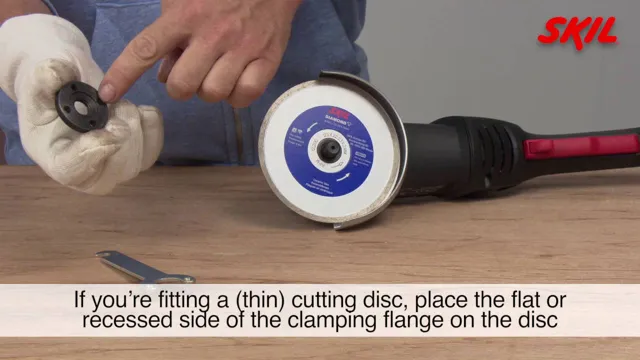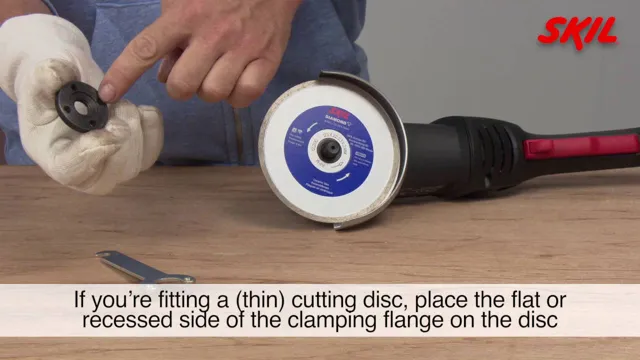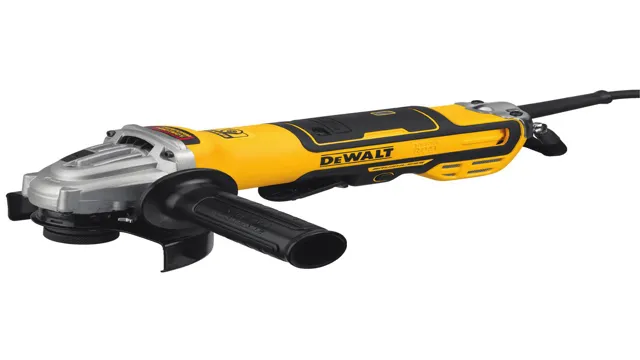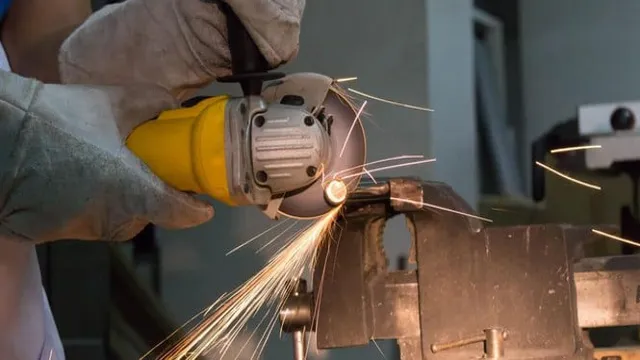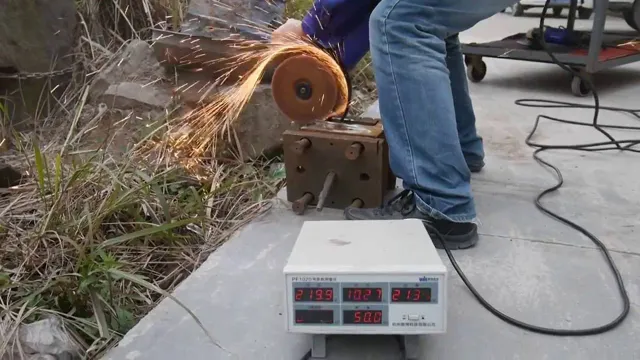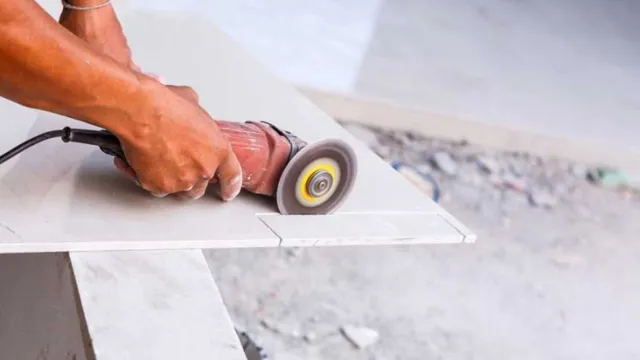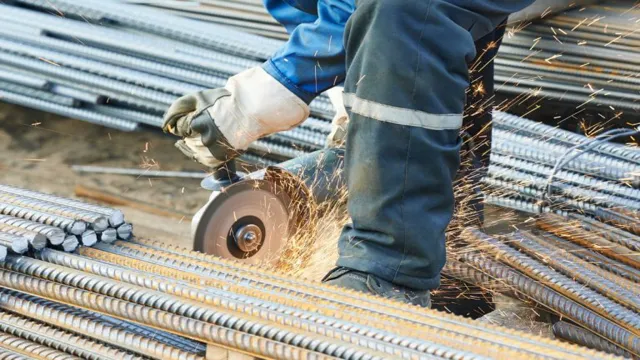Can I Cut Wood with an Angle Grinder? A Comprehensive Guide to Cutting Wood with Ease
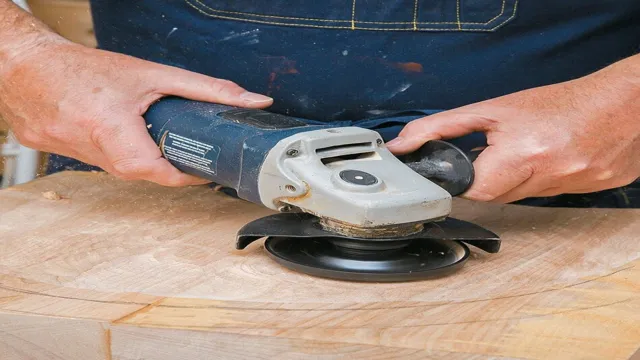
If you’re looking for a way to cut wood that’s quick, easy, and doesn’t require specialized tools, then using an angle grinder may be just what you need. While this versatile tool is primarily used for grinding and cutting metal, with the right blade it can easily slice through wood, too. But before you dive in, it’s important to know what you’re doing.
From choosing the right blade to ensuring proper safety measures are in place, there are several things you need to keep in mind when cutting wood with an angle grinder. In this blog post, we’ll walk you through everything you need to know to get started, so you can make efficient and accurate cuts without damaging your tool, workpiece, or yourself. So if you’re ready to take your woodworking skills to the next level, read on!
What is an Angle Grinder?
An angle grinder is a versatile power tool that is commonly used for cutting, grinding, and polishing materials such as metal, concrete, and tiles. But can you cut wood with an angle grinder? The answer is yes, but with some precautions and considerations. First, make sure that you use the appropriate blade for cutting wood.
Unlike metal or concrete blades, wood blades have fewer teeth and larger spaces between them to prevent clogging and overheating. Secondly, wear proper eye and ear protection since wood chips and sawdust can fly and create loud noise. Lastly, secure the wood piece on a sturdy surface or clamp it down to prevent it from moving while cutting.
With these steps, you can use an angle grinder to make precise and smooth cuts on wood. However, keep in mind that an angle grinder can be a dangerous tool if not handled properly, so always follow safety guidelines and use the tool responsibly.
Definition and Function
An angle grinder is a versatile hand-held tool that is commonly used in metalworking, construction, and woodworking. It is designed with a rotating disc that can remove material or polish surfaces. The disc can be swapped for different types of attachments depending on the task at hand.
Angle grinders are available in various sizes, power outputs, and designs, making them suitable for a broad range of applications. They typically use electric motors, but some models can be powered by compressed air. The primary function of an angle grinder is to grind, cut, and shape materials with precision and efficiency.
Its design allows it to tackle a variety of tasks, including removing rust and other surface impurities, cutting materials for welding or construction, and shaping wood before painting or staining. Overall, an angle grinder is an essential tool for professionals and DIY enthusiasts alike due to its versatility, power, and precision.
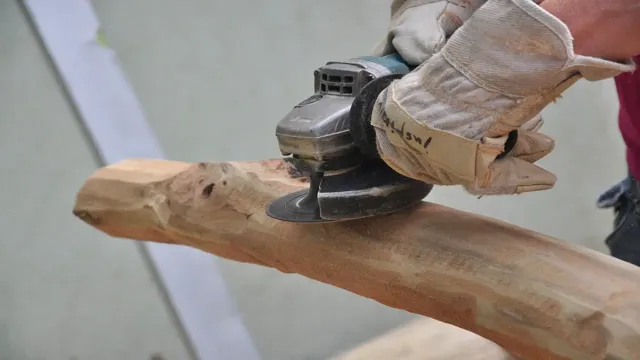
Types of Angle Grinders
An angle grinder is a versatile tool that can be used for a variety of tasks such as cutting, grinding, polishing, and sanding. It looks like a handheld circular saw with a round blade that comes in different sizes, ranging from 5 inches to 9 inches in diameter.
Angle grinders are powered by electricity, gasoline, or compressed air, and they feature a rotating disc or wheel that spins at high speeds to perform different functions. There are two main types of angle grinders: corded and cordless. A corded angle grinder is powered by electricity and requires a power outlet to operate, while a cordless angle grinder is battery-powered and provides greater portability and convenience.
Other types of angle grinders include paddle switch, slide switch, and variable speed grinders, which can be adjusted for speed and power. Each type of angle grinder has its own benefits and drawbacks, and choosing the right type depends on the user’s specific needs and preferences.
Can an Angle Grinder Cut Wood?
Can I cut wood with an angle grinder? Yes, you can! An angle grinder can absolutely be used to cut wood, but it’s important to keep in mind that this tool is primarily designed for cutting through metal and other hard materials. When cutting wood with an angle grinder, it’s important to use the right kind of blade and take proper safety precautions, such as wearing eye and ear protection and securing the piece of wood you’re cutting. A standard abrasive blade is not the best tool to use for cutting wood, as it can cause the wood to splinter and kickback towards the user.
Instead, it’s better to use a specialized wood cutting blade with larger teeth that are designed to cut through wood cleanly and efficiently. As with any power tool, it’s important to use an angle grinder safely and responsibly, so make sure to read the user manual carefully and take any necessary precautions before getting started. So, next time you need to cut a piece of wood, don’t hesitate to reach for your trusty angle grinder – just make sure you do it safely and with the right kind of blade!
Pros and Cons of Cutting Wood with an Angle Grinder
An angle grinder is a tool designed for cutting, grinding, and polishing various materials, including wood. Although it’s possible to cut wood with an angle grinder, it comes with its own set of advantages and disadvantages. On the one hand, an angle grinder can make quick and precise cuts, especially in tight or difficult-to-reach areas, and it’s relatively inexpensive and easy to use.
On the other hand, an angle grinder is not the ideal tool for cutting wood as it can quickly destroy the blade and create a lot of sawdust. Additionally, an angle grinder can be difficult to control and may cause the wood to split or warp. Furthermore, safety is always a concern when using an angle grinder as it’s a powerful tool that can cause serious injuries if not handled properly.
In conclusion, while an angle grinder can cut wood, it’s not the best tool for the job due to its limitations and potential hazards. It’s always recommended to use a saw specifically designed for cutting wood.
How to Cut Wood with an Angle Grinder
Angle Grinder Cut Wood Yes, an angle grinder can cut wood. Although it’s a tool commonly used for metalworking, an angle grinder’s powerful motor and sharp disc make it well-suited for cutting through different materials, including wood. When using an angle grinder to cut wood, there are a few things you should keep in mind.
First, it’s important to choose the right type of blade – a diamond-tipped blade is necessary for cutting through hard or thick woods, while a standard saw blade will suffice for softer woods. Next, make sure you have a stable work surface to keep the wood secure and prevent it from shifting while you work. And lastly, be sure to wear appropriate safety gear – glasses, gloves, and a dust mask are essential to protect yourself from flying wood chips and sawdust.
Overall, with the right blade, technique, and safety precautions, an angle grinder can be a useful tool for cutting wood.
Safety Precautions
Angle Grinder Cut Wood Angle grinders are powerful tools that are commonly used in workshops for cutting, grinding, and polishing. When it comes to cutting wood, an angle grinder can be used with the right blade attachment, but it’s not the best tool for the job. While a wood-cutting disc can be fitted to an angle grinder, it can be quite dangerous, as the extreme speed of the grinder can cause the blade to shatter when cutting through wood.
This can result in flying debris and cause serious injury to the operator or anyone nearby. Additionally, the sawdust produced by the cutting process can be a fire hazard if it’s not managed properly. Therefore, it’s important to follow all safety precautions when using an angle grinder for cutting wood, such as wearing appropriate protective gear and using a blade that’s specifically designed for wood cutting.
Ultimately, it’s recommended to use a saw or another specialized tool for cutting wood.
Choosing the Right Blade for Cutting Wood
Yes, you can cut wood with an angle grinder. However, it’s important to choose the right blade for the job. The most common type of blade for cutting wood with an angle grinder is a circular wood cutting blade.
These blades typically have carbide-tipped teeth that can easily slice through most types of wood. When choosing a blade, it’s important to consider the thickness and type of wood you’ll be cutting, as well as the size and power of your angle grinder. Using a blade that’s too small for the job can be dangerous and ineffective, while a blade that’s too large can cause unnecessary wear and tear on your grinder.
It’s also important to wear safety gear such as gloves, eye protection, and a dust mask to protect yourself from wood chips and sawdust. By selecting the right blade and taking proper safety precautions, cutting wood with an angle grinder can be a quick and efficient task.
Types of Blades for Cutting Wood
When it comes to cutting wood, using the right blade is essential. There are several types of blades available, and each is designed for a specific purpose. For instance, rip blades are great for cutting with the grain, while crosscut blades are better suited for cutting across the grain.
Combination blades can be used for both types of cuts, making them a versatile option. Additionally, there are specialized blades for cutting curved shapes or for making intricate designs. Ultimately, choosing the right blade depends on the type of wood you are cutting and the desired outcome of your project.
Always make sure to choose a blade with the appropriate tooth count and size for the job at hand. By taking the time to select the right blade, you can ensure clean, precise cuts that will enhance the overall quality of your project.
Factors to Consider When Choosing a Blade
When it comes to cutting wood, choosing the right blade is crucial. There are several factors to consider, such as the type of wood you will be cutting, the thickness of the wood, and the type of saw you will be using. The first thing to consider is the number of teeth on the blade.
Blades with more teeth are better for making smoother, cleaner cuts, while blades with fewer teeth are better for rougher, faster cuts. You should also consider the material the blade is made of. High-speed steel blades are great for softer woods like pine or cedar, while carbide-tipped blades are better for harder woods like oak or maple.
Ultimately, the right blade for you will depend on the type of cutting you will be doing and the type of saw you will be using.
Conclusion: Is Cutting Wood with an Angle Grinder Right for You?
In conclusion, while an angle grinder may technically be able to cut wood, it’s not the best tool for the job. You’re more likely to end up with rough, uneven cuts and potentially dangerous situations. It’s like trying to peel a potato with a chainsaw – sure, it might work, but there are far better and safer options available.
So, stick to using a saw for woodcutting and save your angle grinder for metalworking. Let’s not put our safety at risk for a DIY hack!”
FAQs
What type of blade is best for cutting wood with an angle grinder?
A wood carving disc or a circular saw blade with carbide tips are both good options for cutting wood with an angle grinder.
Can an angle grinder be used to shape wood?
Yes, an angle grinder with a sanding disc attachment can be used to shape wood.
Is it safe to cut wood with an angle grinder?
Yes, it can be safe to cut wood with an angle grinder as long as appropriate safety measures are taken and the correct blade is used.
What type of safety equipment should I wear when cutting wood with an angle grinder?
Safety goggles or a face shield, gloves, and ear protection are recommended when using an angle grinder to cut wood.
How do I prevent kickback when cutting wood with an angle grinder?
Using a push stick or clamp to hold the wood in place can help prevent kickback while cutting with an angle grinder.
Can I use an angle grinder to cut wet or dirty wood?
It is not recommended to use an angle grinder to cut wet or dirty wood as it can damage the blade and increase the risk of injury.
Is it difficult to cut precise shapes with an angle grinder?
Cutting precise shapes with an angle grinder can be challenging, but using a template or guide can help achieve more precise cuts.

